A person. Alan Kay - the prophet, the author of the concept of GUI and the language of Smalltalk
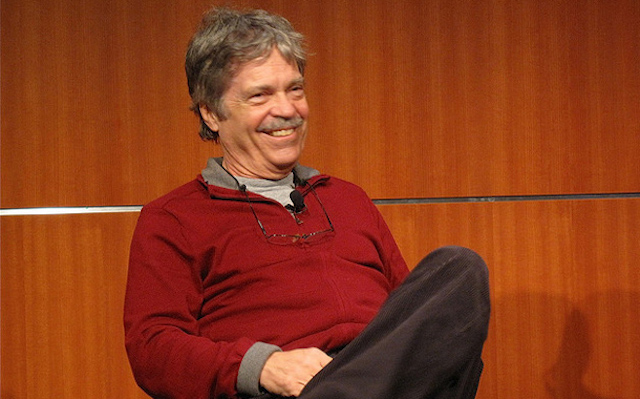
Alan Kay loves to refer to himself, and often begins his speech with the phrase: "Kay's law number one reads ...". He probably has that right. For many years he was underestimated, pounded into frames, and even spread rot.
Alan Kay is a person who cannot keep his opinions to himself if the topic of discussion really excites him. For this he had to pay a couple of times. However, he was lucky, and as a result he remained the winner. In his case, the saying is true: "Everything that is done is all for the best."
')
Due to a strange coincidence, Kay became involved in software development, and later turned out to be a pioneer in the areas of object-oriented programming and graphical interface. On this path, he invented and realized what seemed impossible earlier, which most of his colleagues simply did not think about. “The simple must remain simple. The complex should be possible, ”is his life credo.
Against the system
Alan Kay was born in Springfield, Massachusetts. Shortly after his birth, the family moved to Australia, where he lived the first years of his life. During World War II, fearing the threat of a Japanese invasion, his parents decided to return to the United States.
A gifted child, at the age of three, learned to read and, as he grew older, he continuously expanded his horizons with new knowledge. At the age of ten, Alan Kay became the winner of the National Quiz game.
“When I went to school, I already read a couple of hundred books. I knew in the first grade that they were lying to me because I already had my own point of view. They (the teachers) didn't like the idea of different points of view, so it was a battle, ”Kay said.Indeed, knowing more than all his classmates and most of the teachers, he could not help but demonstrate it. But extraordinary abilities and not for years developed mind became a reason for ridicule from the side of peers and harassment from the side of teachers. Thus, the system turned the advantages of the child into disadvantages.
Among other things, Kay studied music since childhood. His mother was a musician and an artist. Even in elementary school, he was a soloist in the choir and already at an early age he played the guitar well. In fact, he expected to become a professional musician. Later he tried his hand as a composer and theater director, and then he became generally interested in classical organ music.
In 1961, for participating in a protest against the introduction of a percentage quota for Jewish students, he was expelled from college. Then Kay went to Denver, where he became a jazz musician and gave guitar lessons to earn a living.
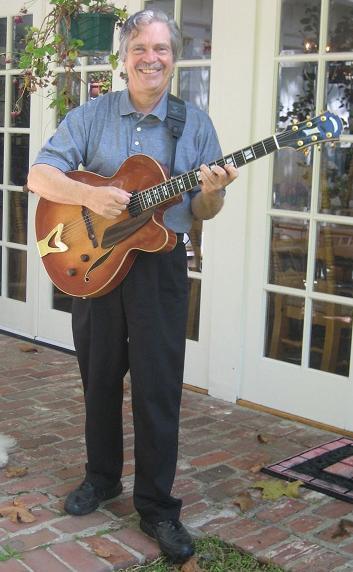
Turn in career
But another talent that brought him much greater fame suddenly showed up at Kay ... in the army, where he volunteered. No, it's not about the virtuoso ability to sweep asphalt with a rake: testing has shown that he has brilliant programming skills. In this regard, Kay was sent to the US Air Force to work on the computer IBM 1401. This was a crucial moment in his career.
Alan served on the Randolph military base, where he worked with the Burroughs 220 computer.
Burroughs 220 is a tube computer from Burroughs Corporation, which was then located in Detroit. It was developed in 1957 by Electrodata Corporation and was called Electrodata Datatron 220 before Electrodata was absorbed by Burroughs. At different times, the device cost from $ 601,000 to $ 325,000 and performed multiplication in 2, and the division in almost 4 microseconds.
Universities
After serving in the Air Force, Alan Kay was sent by the National Center for Atmospheric Research to the University of Colorado in the Department of Mathematics and Molecular Biology.
After receiving a bachelor's degree, in 1966 he entered the University of Utah in the Faculty of Engineering. By that time, Kay realized that he would devote his life to IT technologies.
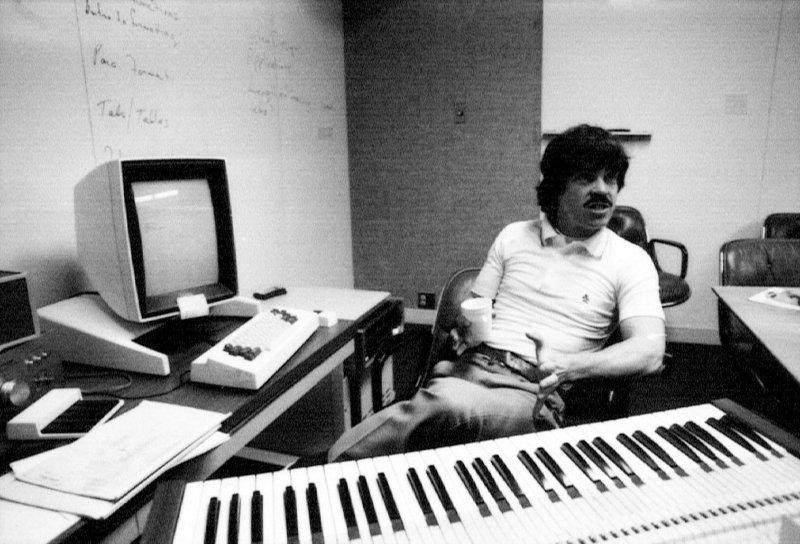
It was there that there was an acquaintance with the works of Ivan Sutherland, one of the creators of virtual reality. There, Kay began programming in the Simula language. Combining ideas in the field of programming and biology, he formulated the principle of biological analogy. He argued that the ideal computer should be similar to a living organism, where each cell is individual, but together they can form a single system capable of regrouping and changing the structure.
From 1967 to 1969, Alan Kay developed software for the Flex computer as part of his dissertation. Although Flex was not put into mass production, it essentially became a prototype of a personal computer.
When working on FLEX, an attempt was made to optimize the performance of the computer so that the user could receive feedback from him faster.
Although FLEX was a technical innovation, it was very complex. According to Kay, "users were repelled by difficulty in learning." The problem was not in the equipment, but in a special language that the user had to master in order to get the desired results. So for the first time, Alan Kay made sure that software development should go in a direction that facilitates the work of a person with a personal computer.
In the fall of 1968, Kay had another significant meeting, which largely influenced his future. He met Seymour Pipert and spent some time working with him in artificial intelligence laboratories at Massachusetts Technological and Stanford Universities. Pipert is called the father of the programming language Logo.
Paypert and Douglas Englebart, who became his associate, tried to turn a heavy machine (at that time, except for the mainframe, nothing happened) from a “train” moving along company-limited paths into a “car” with freedom of movement.
“In 1968, I first saw Seymour Paperper working with children and LOGO, and I learned a truly effective handwriting recognition system. This is an incredible system ... When I combined this with the idea that children should use it, the concept of a computer gained a sense of super-environment, ”recalls Alan Kay.At this time, he had a plan to create the first ever personal computer model - the Dynamic Book.
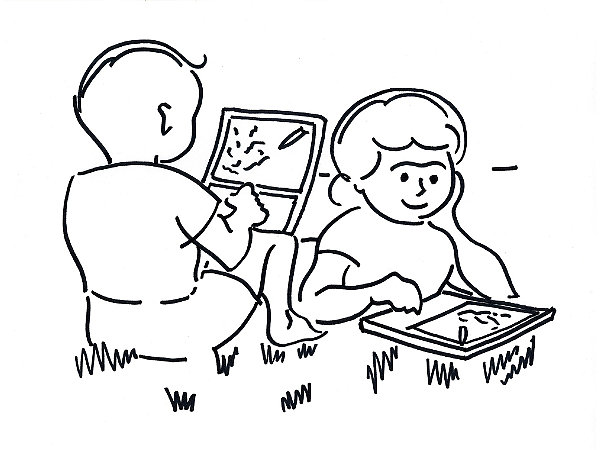
In 1969, Kay defended his doctoral thesis, in which he developed the principles of creating a personal computer - a powerful but simple to manage. After that, Alan Kay became a professor at Stanford University and worked for two years at the Stanford Artificial Intelligence Laboratory.
There he began to think about a book-sized computer that could be used instead of paper.
Continuing to work on the problem of teaching children using a computer, Alan Kay identified three methods of possible learning:
The first is memorization of instructive stories; sometimes they are formulated in the form of aphorisms, proverbs and sayings. These are also folk traditions, folklore ... The second method is the method of logical reasoning, the method of studying chains of cause-and-effect relationships, the way of mathematics and formal logic. The third method remains - this is the “system dynamics” method. The method of formation in the brain of intuitive pictures of the behavior of certain objects and systems belonging to the outside world.
The book - the main Keeper of the achievements of Civilization - is suitable for the transfer of knowledge when using the first and second of the considered methods. In the book you can collect wonderful stories, wise aphorisms and instructive sayings. In the book, you can set out a mathematical discipline. But the book is almost not suitable for the transfer of knowledge by the method of "system dynamics".
Xerox
With such baggage, Kay in 1972 took the position of the head of the Advanced Research Group (Learning Research Group) at the Xerox Palo Alto Research Center (PARC). At that time, the company practically achieved a monopoly in the market of copy machines and sought to expand the scope of its activities.
The Xerox management decided to stake on scholars: to allow them to conduct research within the company, to give a blank check, but at the right moment to use the results of their activities for the benefit of the company.
In the early 1970s, it seemed to many that "just about" paper carriers of information and funds from service would be lost. Something else had to come. It was clear that the basis should be a computer. Alan Kay and the team had to figure out exactly how this can be implemented.
Oddly enough, the bohemian atmosphere contributed to an amazing performance in a creative setting. Perhaps it was in such conditions that the prerequisites of the phenomenon called “personal computer” could have arisen. Today, when several generations of PCs have changed, the reasoning that occupied the best minds at that time may seem naive. But it was from them that the ideas of the graphical user interface and object-oriented programming grew.
But in addition, it was necessary to solve a number of problems that were by no means technical, including the problem of the relationship between the message and the information carrier. The first thing that happened was to interpret the computer as “super paper”. Now the idea that the computer, originally intended for computing, could become digital media, a carrier of information, is taken for granted. Then this thought was a breakthrough.
Working on the relationship between message semantics and media, Kay wrote:
“Any message in one sense or another models some idea. It may be concrete or abstract. The properties of the media largely determine how the message can be recognized, edited and saved. Although computers were invented for arithmetic calculations, their ability to reproduce the details of any descriptive model allows the computer itself to be viewed as a carrier of information, it can combine the properties of other media. ”
Dynabook Prototype Laptop
Analyzing the reaction of children when communicating with a computer, Kay noticed that children perceive images and sounds better than simple text. Together with other researchers from PARC, Kay developed a simple computer system that intensively used graphics and animation.
Many children have adapted very well to the use of this system; they have learned to solve quite complex tasks in it. This system is called "DynaBook".
In March 1977, Alan Kaye and Adele Goldberg sent an article entitled “Personal Dynamic Media” to Computer magazine.
“Imagine that you can have your own knowledge navigator in a portable package with the size and shape of a regular notebook ... Assume that it has enough capacity to save thousands of pages of source materials, poems, letters, recipes, records, drawing data, animations , ... dynamic models, and anything else that you would like to save and edit. DynaBook can be used for reading or writing as a regular book with illustrations, but it (DynaBook) provides much more possibilities: a dynamic search can be carried out for an individual context, ”wrote Kay and Goldberg.Kay described the DynaBook as a portable interactive device with a flat-panel touchscreen, wireless communication system and multimedia capabilities. Here the principle of WYSIWYG (what you see is what you get), text editors and a drawing system were assumed.
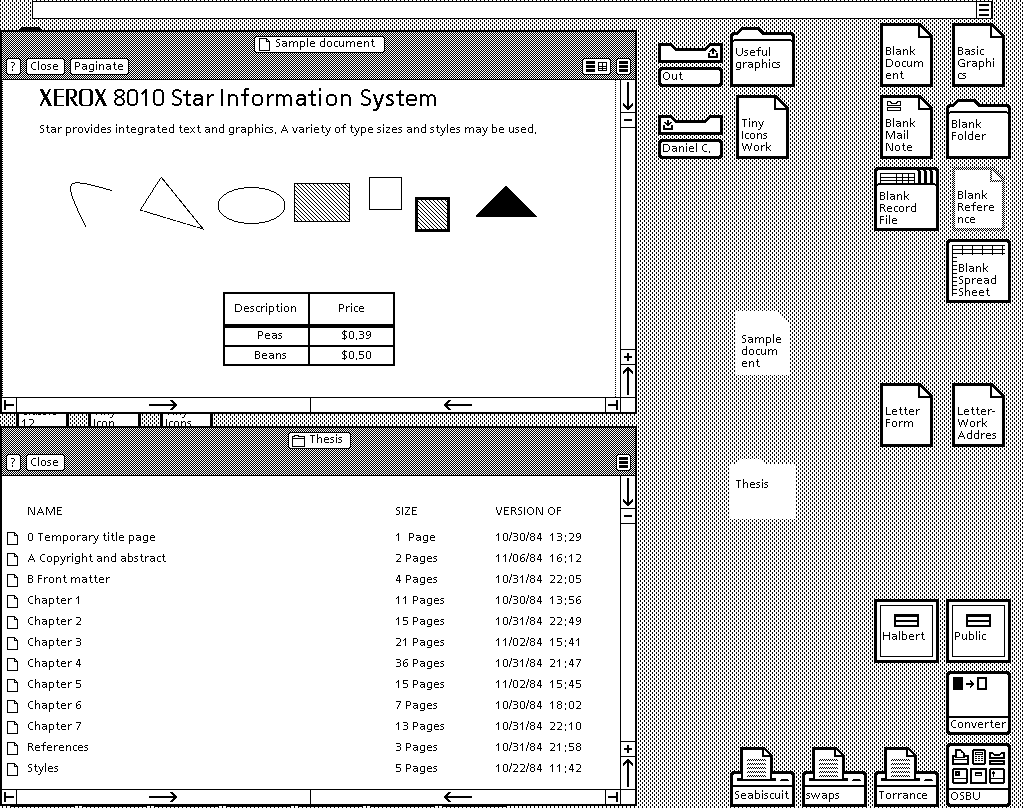
For this car of the future, the Star GUI was designed and modeled to include all the elements we were familiar with today - windows, icons, menus and much more. Star GUI is the prototype of the Macintosh interface.
The Dynabook project was never completed, but its role in the IT industry is obvious.
Smalltalk
The most significant practical result of the work of Alan Kay at Xerox PARC was the creation of the Smalltalk language. The programming languages that existed at that time were mainly focused on solving computational problems. They had the necessary tools for working with symbols, but they were too complex and did not fit the Dynabook project. Therefore, the development of a new language was given high priority. Some of his ideas were borrowed from Simula and Pipert, who created the Logo language based on the works of the French psychologist Jean Piaget.
For two years, starting in 1970, Alan Kay worked on the Smalltalk language, which was designed to simulate the previously described biological model consisting of cells (or "cells") and the transfer of messages between them. After Smalltalk entered the market (1983), the language became widely popular. It was one of the first object-oriented programming languages to embody a methodology from which parallel systems, databases, and knowledge bases can be created.

Class structure in SmallTalk using 'Rectangle'
Initially it was assumed that the Dynabook programming tool would be quite simple, accessible for children. Its first version, written in BASIC, was released in October 1972. Four months later, a version in assembly language (Smalltalk-72) appeared, and later, in 1974, when it was installed on Alto, it was possible to begin experimental work with children.
In Smalltalk-80, metaclasses were added, which corresponded to the concept of “everything is objects”. Smalltalk-80 was the first version available outside of PARC — first as the Smalltalk-80 Version 1 distributed to a small number of companies and universities for peer review. Later, in 1983, a publicly available implementation, known as the Smalltalk-80 Version 2, was released. These modifications of the language were already "childish."
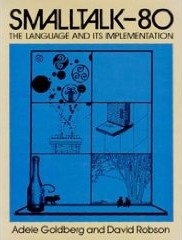
So that the language could be used on different platforms, it was implemented as a virtual machine (Virtual Machine, VM) and a virtual image (Virtual Image, VI). VI was a class library in which Smalltalk functionality was implemented, including the definition of data structures, methods for working with texts and graphics, compilers, decompilers, debuggers. The compiler generated a code in an intermediate language called byte codes. VM provided interpretation of bytecodes on any platform. All this causes associations with Java at the level of subcortex. This speaks of the serious role that SmallTalk has played in programming.
Life after Xerox
In addition to DynaBook and SmallTalk, Alan Kay had other projects. As a research group leader in PARC, Kay contributed to the development of Ethernet, laser printing, and the ARPANet network client-server model.
Kay offered Xerox to invest in some of his projects, but Xerox management did not want to develop his ideas and invest large resources in his work. When Steve Jobs, Jeff Raskin and some other Apple leaders visited PARC in 1979, they immediately saw tremendous prospects in the works of Alan. They were amazed at the idea of a windowed interface and the flexibility of the Smalltalk language. Alan's work at PARC was the seed from which Arple Macintosh grew.
Kay left Xerox in 1983 and, after a short break, became the lead programmer-researcher at Apple Atari, in 1984 - on the Macintosh, the first mainstream computer with a graphical user interface.
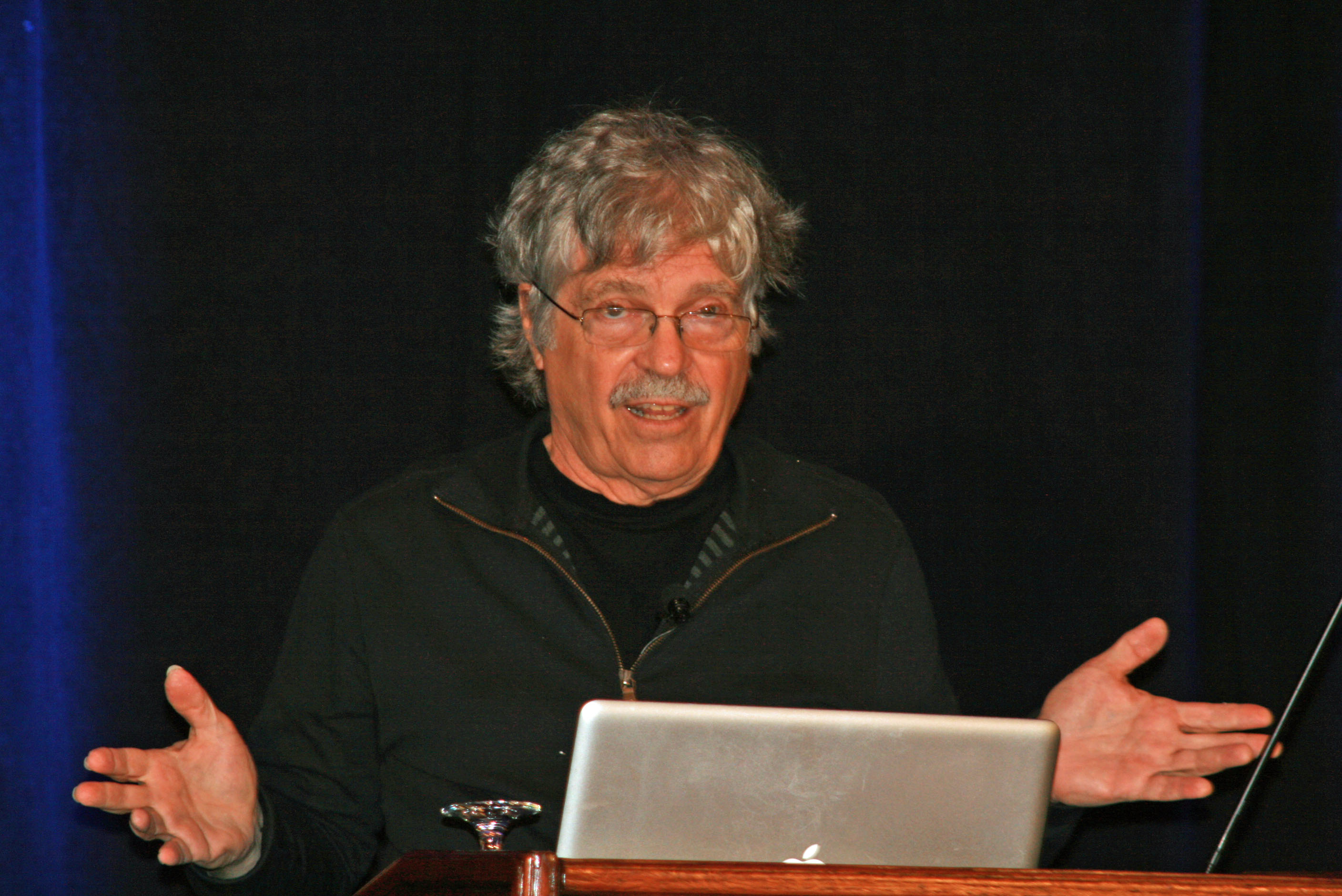
In 1996, Kay moved to the position of vice president of research and development at Walt Disney. He worked at the Walt Disney Imagineering Lab., Where the newest attractions for Disney World parks were developed.
The new millennium was marked by rapid growth in the mobile market, as predicted by Alan Kay.
After leaving Disney in 2001, he founded the Viewpoints Research Institute, a non-profit organization dedicated to children, education, and advanced software development where he is chairman.
In 2003, Kay won the Turing Award for his contribution to the development of object-oriented programming. In 2004, he received the Kyoto Prize.
Later, Kay worked for the Applied Minds team, then became a senior employee (Senior Fellow) at Hewlett-Packard until HP disbanded the advanced software research team on July 20, 2005.
Since 2006, Alan has been developing the STEPS (STEPS Toward Expressive Programming Systems) system for grants from the National Science Foundation.
In 2015, Ilon Musk, together with a group of investors from the IT industry, founded the OpenAI Foundation, which will do research that can prevent the uprising of artificial intelligence against people. The foundation will have a supervisory board headed by Alan Kay.
Mark on history
Alan Kay changed attitudes to computers. Before the ideas of Alan Kay, the computer was a box that displayed text and numbers that the plain people could not understand on the screen. To communicate with the machine, it was necessary to learn a rather complicated language. Kay realized that users can and should interact with the computer in another way and should not be limited to text only.
He was among the first who decided to present objects in the computer as images - a metaphor that further expanded with the advent of object-oriented programming.
Source: https://habr.com/ru/post/317278/
All Articles